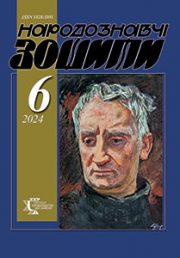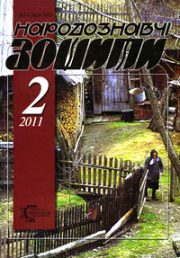The Ethnology Notebooks. 2023. № 4 (172), 1013—1022
UDK 730.027.1:821.161.2Шев]:730.071.1(477+438+436)”18/19″
DOI https://doi.org/10.15407/nz2023.04.1013
SCULPTURAL PORTRAITS OF TARAS SHEVCHENKO IN THE WORK OF STANISLAV ROMAN LEVANDOVSKYI
KUPCHYNSKA Larysa
- ORCID ID: https: //orcid.org/0000-0001-6461-4819
- Candidate of Art History, Associate Professor,
- Director at the Research Institute of Art Library Resources;
- Vasyl Stefanyk National Scientific Library of Ukraine in Lviv
- 2, Stefanyka Street, Lviv, Ukraine, 79000,
- Contacts: e-mail: oklarysa@gmail.com
Abstract. The article deals with little-known pages from the early period of the work of the famous European artist of modern times, Stanislav Roman Levandovskyi. The main focus is made on two sculptural portraits of Taras Shevchenko, which are mentioned only briefly in the literature. It emphasizes the relevance of the research topic.
The purpose of the publication is to reveal the historical, cultural and artistic features of the key works of S.R. Levandovskyi in the context of time. By studying periodicals of the second half of the 19th century, the date of the busts has been determined. The article presents the organizations for which they were intended, the specified exhibitions at which they were exhibited. Attention is paid to S.R. Levandovskyi’s cooperation with the Ukrainian society «Sich» in Vienna and the Ukrainian youth organization «Academic Community» in Krakow, and the nature of his participation in the celebration of the 75th anniversary of the birth of T. Shevchenko is determined. It is proven that when performing the bust of T. Shevchenko in a striped cap and coat, the author took into account the aesthetic priorities of the Western Ukrainian society, which is well acquainted with the lithography of Volodymyr Hutovskyi, the painting of Gavril the painter, and the sculptural portraits of Mykola Ramazanov, Parmen Zabyla, Tadei Baronch. The article proves S.R. Levandovsky’s familiarity with the achievements of Fedor Kamenskyi, whose works he could see in Kyiv in the 1880s. For the young artist, the personal acquaintance of an older colleague with T. Shevchenko, whose sketches for a sculptural bust appeared during his lifetime, was important. This played a decisive role in the emergence of a distinctive image of the poet, which corresponded to the artistic trends not only in Kyiv, but also in Vienna. A common feature of the two works is increased attention to details and exaltation of the portrait. Sculptural portraits of T. Shevchenko, executed by S.R. Levandovskyi, received wide resonance from the time of their appearance. Combining different artistic traditions, they reflect the scale of the sculptor’s talent. Created in accordance with the requirements of the time, they are part of the treasury of national culture.
The research methodology is based on the complex involvement of various methods, principles and concepts.
Keywords: Stanislav Roman Levandovskyi, Taras Shevchenko, sculptural portrait, reinterpretation, interpretation.
Received 19.07.2023
REFERENCES
- (1885). From the exhibition of competitive projects for the Mickiewicz monument. Spikelets, 1024, 99 [in Polish].
- (W., Ј. [Јuszczkiewicz, W.]). (1885). Death of Vaidelot — Levandovskyi’s sculpture. Time, 217, 3 [in Polish].
- Czapelski, T. (1886). «Zaporizhia Cossack». Illustrated weekly, 175, 303 [in Polish].
- Czapelski, T. (1886). M. Stanislav Levandovskyi. Illustrated weekly, 187, 79 [in Polish].
- Somochkin, I. (2004). «Altars of the people»: monuments to Adam Mickiewicz and Taras Shevchenko in Lviv. Sights of Ukraine, 1, 114—127 [in Ukrainian].
- Biryulyov, Yu. (2015). Lviv sculpture from early classicism to avant-garde (mid-18th — mid-20th centuries). Lviv: Apriori [in Ukrainian].
- (1889). From Krakow. Work, 71, 2 [in Ukrainian].
- (1889). From Krakow. Work, 135, 2 [in Ukrainian].
- (1889). Catalog of the permanent exhibition of the Society of Friends of Fine Arts in Krakow in Sukiennice. Krakow: In the printing house «Time» [in Polish].
- (1890). Catalog of the permanent exhibition of the Society of Friends of Fine Arts in Krakow in Sukiennice. Krakow: In the printing house «Time» [in Polish].
- (1891). Catalog of the permanent exhibition of the Society of Friends of Fine Arts in Krakow in Sukiennice. Krakow: In the printing house «Time» [in Polish].
- (1861). Shevchenko’s death. Word, 15, 78 [in Ukrainian].
- (1861). The death of Shevchenko and his «Haidamaky». Voice, 68, 4 [in Polish].
- Sydor, Oleh (Ed.). (2014). Owner of the Ukrainian spirit: Lviv artist Shevchenkiana. Lviv: Club of Ukrainian artists [in Ukrainian].
- (1862). For the repose of the soul of the blessed memory of Taras Shevchenko. Word, 16, 61 [in Ukrainian].
- (1862). We extract the following fragment to the novelties… Word, 16, 64 [in Ukrainian].
- V., Sh. [Shashkevych, V.]. (1862). Taras Shevchenko’s memorial service in Lviv. Word, 17, 68 [in Ukrainian].
- (1863). Years after Shevchenko. Vechornytsi, 9, 66 [in Ukrainian].
- (1863). The following descriptions of this Divine Service have also been sent to us… Word, 17, 72 [in Ukrainian].
- Petrykevych, V. (1914). The history of the Shevchenko cult among high school youth: Jubilee Studio. Peremyshl: From the printing house of the Greek Catholic Chapter [in Ukrainian].
- Shchurat, V. (1911). Celebration of the anniversary of Shevchenko’s death in Galicia 1862—1870. Sunday, 11/12, 5—8 [in Ukrainian].
- Vozniak, M. (1911). Birth of the cult of Shevchenko in Galicia. Sunday, 11/12, 1—5 [in Ukrainian].
- (1864). Ukrainian guys in Lviv… Word, 19, 76 [in Ukrainian].
- (1866). Anniversary of the death of Taras Shevchenko. Mermaid, 10, 74, 75 [in Ukrainian].
- (1869). This Wednesday… Truth, 8, 76 [in Ukrainian].
- Svientsitskyi, I. (Ed.). (1920). Catalog of the Shevchenko exhibition with a portrait of T. Shevchenko’s father. Lviv: From the printing house «Work» [in Ukrainian].
- Sydor, O. (2014). Some notes on the history of Lviv artistic Shevchenkiana. The Ethnology Notebooks, 6, 1112—1141 [in Ukrainian].
- (1862). On Wednesday, February 14 (26)… Word, 14, 56 [in Ukrainian].
- (1862). Declamation evening on April 24… Word, 31, 124 [in Ukrainian].
- (1862). Last Sunday, December 16… Word, 100, 390 [in Ukrainian].
- (1886). Celebration of Shevchenko’s memory. Work, 23, 1, 2 [in Ukrainian].
- (1880). Music and declamation evening of the academic gymnasium. Work, 18, 4 [in Ukrainian].
- (1883). Pupils of the Ukrainian gymnasium. Work, 28, 3 [in Ukrainian].
- (1882). From Drohobych. Work, 16, 2 [in Ukrainian].
- Rybchynska, N. (1989). To the history of the Kobzar monument. October, 11, 133, 134 [in Ukrainian].
- Zhuk, S. (1946). Portrait of T. Shevchenko in sculpture. Augsburg: Ukrainian Free Academy of Sciences [in Ukrainian].
- (1872). Bust of Shevchenko. Truth, IV, 198 [in Ukrainian].
- Zawadzki, W. (1874). Lviv, in December. Illustrated weekly, 315, 28 [in Polish].
- Nimenko, A.V. (1963). Ukrainian sculpture of the second half of the 19th — beginning of the 20th century. Kyiv: Publishing House of the Academy of Sciences of the Ukrainian SSR [in Ukrainian].
- (1889). Na-yi. From Vienna. Work, 48, 1, 2 [in Ukrainian].
- (1861). In the bookstore Dm. Ef. Kozhanchykova…. Basis, 10, 157 [in Ukrainian].
- Adamenko, A.H., Vizyr, M.P., & Lysochenko, I.D. (Eds.). (1966). T.G. Shevchenko in the epistolary of the manuscripts department. Kyiv: Naukova dumka [in Ukrainian].
- (1892). Lvivskyi hist. 31st anniversary of the death of Taras Shevchenko in Vienna. Work, 50, 2 [in Ukrainian].






